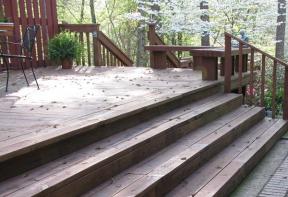Choose your deck materials
Know your options before you design your new deck
Materials
Choosing the material for your new deck isn’t as simple as wood versus composite.
If solid wood is your preference, you can choose pressure-treated lumber, which is the most inexpensive material option. You have to get used to the green tint and carefully consider all your hardware, but this lumber is sure to last a few decades. You can also pick the classic look of cedar. It’s a great outdoor material, but it will cost you more money up front and on maintenance (especially refinishing). You could also discover the less used (but still hearty) options of alternative woods such as cypress and redwood.
Composite woods are a combination of recycled plastics and wood. The look of these boards has improved considerably over the years, but, upon close inspection, some builders still aren’t happy with the way these products attempt to mimic real wood. However, if low-maintenance–a quick power wash every spring is all you need–is appealing, then you need to decide on solid or hollow-core composite. Solids work like real wood and give you more design options (such as a routed edge) but hollow-core is lighter to work with and is often cheaper.
It’s important to note that while composites can be used only for the decking and rails, you’ll need solid wood for the entire support structure.
Find a balance between price, long-term maintenance and aesthetics.
Foundation
Put your best foot forward when designing a deck–literally. The feet or foundation of a deck is the starting point for success or failure. There are two main options: precast deck blocks or poured concrete piers.
Deck blocks are easy to install. They support the deck above grade with a firm base over your soil. However, if your soil is soft enough to allow the deck to shift, you’ll be sorry. Concrete bases work best with very low heights and small decks on light, well-drained soil that doesn’t heave seasonally.
 Concrete piers take more effort, but, if they’re properly installed, they will support a deck without moving at all throughout its lifetime. This system involves holes dug to the frost line (check your local requirements) with concrete poured into tubular cardboard forms. For extra resistance to frost heaving, wrap the cardboard in black poly and add rebar to the concrete pier. To finish it off, add a post saddle to the top of the wet concrete.
Concrete piers take more effort, but, if they’re properly installed, they will support a deck without moving at all throughout its lifetime. This system involves holes dug to the frost line (check your local requirements) with concrete poured into tubular cardboard forms. For extra resistance to frost heaving, wrap the cardboard in black poly and add rebar to the concrete pier. To finish it off, add a post saddle to the top of the wet concrete.
For the posts themselves, 4x4s make for a sturdy structure; however, choosing 6x6s adds strength and visual presence to your deck.
Pick above- or below-grade footings based on your deck and soil.
Fasteners
The screws you use can make or break your DIY deck. Pick the wrong screws and you’ll either be sorry as you build (with lengths that are too short or too long) or very sorry later (with screws that corrode over time). These little wonders hold the whole project together, so consider all your options before you buy.
Narrow your search to screws made specifically for decks. They are made to drive smoothly into your deck materials. Next, look at what the fasteners are made of. If you are using pressure-treated lumber, you need the best screws. The strongest choice is stainless steel; however, these screws will add a lot to your budget. Look for screws rated safe for the ACQ chemicals used to make pressure-treated wood, including hot-dipped galvanized fasteners.
The right screw length depends on the thickness of your boards. Be sure the screw penetrates at least 1 1/2″ into the joist below.
One final note: the Canadian-invented Robertson head is your best bet for great driver bit grip and torque.
From tip to tail, be sure your screws are compatible with your wood
Jump to a section
- Page 1 : Materials, foundation and fasteners
- Page 2 : Frame, rails & stairs and finishing your deck
To leave a comment, please log in












No comments